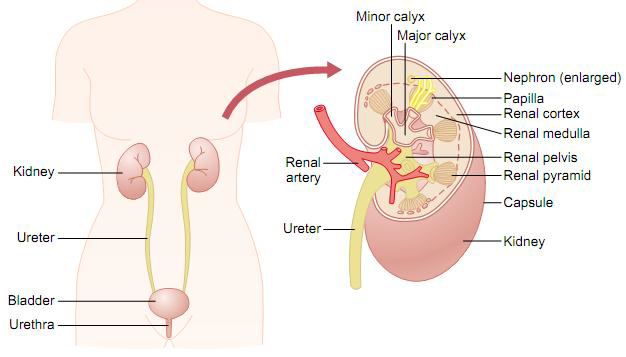Physiologic Anatomy of the Kidneys
Physiologic Anatomy of the Kidneys
The two kidneys lie on the posterior wall of the abdomen, outside the peritoneal cavity. Each kidney of the adult human weighs about 150 grams and is about the size of a clenched first. The medial side of each kidney contains an indented region called the hilum through which pass the renal artery and vein, lymphatics, nerve supply, and ureter, which carries the final urine from the kidney to the bladder, where it is stored until emptied. The kidney is surrounded by a tough, fibrous capsule that protects its delicate inner structure.

If the kidney is bisected from top to bottom, the two major regions that can be visualized are the outer cortex and the inner region referred to as the medulla. The medulla is divided into multiple cone-shaped masses of tissue called renal pyramids. The base of each pyramid originates at the border between the cortex and medulla and terminates in the papilla, which projects into the space of the renal pelvis, a funnel-shaped continuation of the upper end of the ureter. The outer border of the pelvis is divided into open-ended pouches called major calyces that extend downward and divide into minor calyces, which collect urine from the tubules of each papilla. The walls of the calyces, pelvis, and ureter contain contractile elements that propel the urine toward the bladder, where urine is stored until it is emptied by maturation.
Each kidney consists of about one million nephrons. The nephron is made up of a glomerulus and its tubule. The tubule is made up of a number of sections, the proximal tubule, the medullary loop (loop of Henle), and the distal tubule which finally empties into the collecting duct.
There Are Two Populations of Nephrons in the Kidney
- Cortical: These nephrons (approximately 85%) lie within the cortex of the kidney and have short loops of Henle which dip only into the outer medulla.
- Juxtamedullary: These nephrons, which constitute the remaining 15%. Lie in the juxtamedullary area of the cortex and are distinguished from their outer cortical neighbors by having long loops of Henle entering the inner medulla to participate in the diluting and concentrating mechanisms of the kidney.